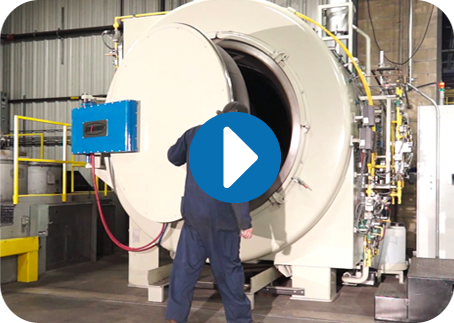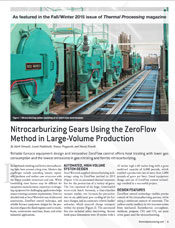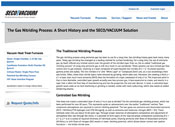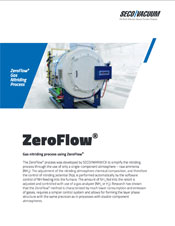Gas Nitriding: A Short History and the SECO/VACUUM Solution
Traditional Nitriding
Gas nitriding using ammonia gas has been in use for a long time. Gas nitriding history goes back many, many years. Today, gas nitriding has emerged as a leading method for surface hardening. For a long time, the use of ammonia gas, by itself, offered very limited control over the growth of the nitrided layer. Even so, the so-called "traditional gas nitriding process" of using only ammonia gas is still very much in use worldwide. These systems use very limited gas flow control and no gas analysis, resulting in a layer composed of superimposed iron nitrides of ε + γ′ +α phases (epsilon, gamma prime and alpha). The iron nitrides ε + γ′ (the "White Layer" or "Compound Zone") are, as a rule exceedingly thick and brittle. Often, these thick nitride layers need removed by grinding, which adds cost. Moreover, creating a thick ε + γ′ + α layer uses much more ammonia (NH3) than the formation of a layer composed of only γ′ + α. The important point is that a more desirable, controlled layer growth actually uses less process gas, is less expensive to create, and results in a layer that is often the final step of manufacturing and has the properties the end user desires. In total, a controlled layer growth saves costs as no hard machining or grinding is needed, unlike with most carburizing, which also needs an added tempering process.

The white layer from nitriding, as well as diffusion zone
Controlled Gas Nitriding
How does one create a controlled layer of only γ′ + α or just α nitrides? Via controlled gas nitriding, which has been performed for over 60 years. This represents quite an advancement over the earlier "traditional" method. Two-component atmospheres are required to control nitriding potential. The two gases are ammonia and dissociated ammonia (NH3 + NH3diss. [75% hydrogen and 25% Nitrogen]), as well as ammonia and molecular nitrogen (NH3 + N2). These methods came into use about 50-60 years ago. Through proper selection of atmosphere composition and adjustment of atmosphere flow rate through the retort, it is possible to form layers of the required phase composition (consisting of ε + γ′ +α, γ′ + α or α zones) of required thickness of individual zones. Diluting ammonia with flows of dissociated ammonia (NH3diss.) or with flows of nitrogen (N2) results in lower nitriding potential, which allows better control over epsilon formation -- the brittle nitride zone. Professor L. Maldzinski, after analysis of the results of experiments with thin iron foils, modified the Lehrer diagram to incorporate iso-concentration curves
As well, his work and that by Lehrer, showed that Nitriding Potential control is very important to crafting nitrided layers. Today, gas nitriding equipment can control these parameters to assure repeatable results.

Lehrer diagram, as modified by L. Maldzinski for nitrogen concentration by Nitriding layers (Epsilon, gamma prime and alpha)
These more controlled processes allow the elimination of final grinding, thus reducing the cost of the whole manufacturing process. However, very precise control has only been possible in recent years with the advent of much more precise and reliable gas analysis methods and more controlled and automated gas flow methods. In the end, these less-controlled methods still result in the consumption of more gases, making them more costly.
Virtually all gas nitriding in use today (so-called controlled gas nitriding) uses one of the two methods of dilution gases (Nitrogen or dissociated Ammonia gas). The additional investment in equipment to make the dissociated ammonia adds to costs. This uses more ammonia, which adds to costs. However, being able to nitride with dissociated ammonia as a dilution gas offers much better control of the nitriding potential. Using Nitrogen as a dilution gas offers less nitriding potential control (and hence less exact layer control), but offers lower equipment costs and less operating costs. With experience and trials, it is often possible for the nitrogen dilution method to offer similar layers as with the use of dissociated ammonia. As can be seen, this is all rather complex. For this reason, ZeroFlow was developed to simplify the process of precision gas nitriding.
SECO/VACUUM's Gas Nitriding with ZeroFlow®
The modern SECO/VACUUM gas nitriding with ZeroFlow carries out controlled nitriding with only ammonia gas, similar to the traditional method. This is a simpler process than that using two-component mixes of ammonia diluted with N2 or NH3diss.2 The regulation of the atmosphere is accomplished through natural dissociation of the ammonia and additions of ammonia, as is required to maintain a certain nitriding potential (Kn). The process starts almost always with pure ammonia in the retort. Thereafter, the nitriding potential quickly reduces to any desired setpoint via the natural dissociation of the ammonia in the presence of the load material and the retort alloy and alloy hardware. The amount of NH3 introduced into the atmosphere is regulated (controlled) with the aid of a gas analyzer (for example an infrared analyzer on Hydrogen). The gas analyzer allows the calculation, with great accuracy, of the nitriding potential and any time the potential drops below setpoint, more ammonia is added via PLC logic. ZeroFlow really is a simple process!

Gas Nitriding Gas Consumption Comparison: Floe Process and ZeroFlow(R) Process
The ZeroFlow process does require one thing – good equipment with tight pressure control and no leaks in the system. For over twenty years, this equipment has evolved to a very nice line of both Vertical (PIT) style units and also front-loading (horizontal) units. The addition of vacuum purging offers a leak-free environment. Vacuum purging also offers cost savings in safety purge gas consumption (nitrogen). In all, the SECO/VACUUM ZeroFlow system is the most advanced gas nitriding equipment on the market. The experience of almost 100 units installed worldwide guarantees reliability. The extensive investment SECO/WARWICK has made in both equipment and in perfecting precision gas nitriding assures ease of nitriding with extreme reliability. The extensive research and production experience gained over 20 years assures end-users they can create the layers desired for all industries and applications, including aerospace and other difficult nitriding applications.


 Video: Cambridge Heat Treating Puts ZeroFlow® Nitriding Process to the Test
Video: Cambridge Heat Treating Puts ZeroFlow® Nitriding Process to the Test
 Case Study: Automaker Saves Money With High Volume Gas Nitriding/Ferritic Nitro-Carburizing System
Case Study: Automaker Saves Money With High Volume Gas Nitriding/Ferritic Nitro-Carburizing System Article: Gas Nitriding, A Short History
Article: Gas Nitriding, A Short History Webinar: Precision Nitriding
Webinar: Precision Nitriding Brochure: Gas Nitriding Using the ZeroFlow® Process
Brochure: Gas Nitriding Using the ZeroFlow® Process

